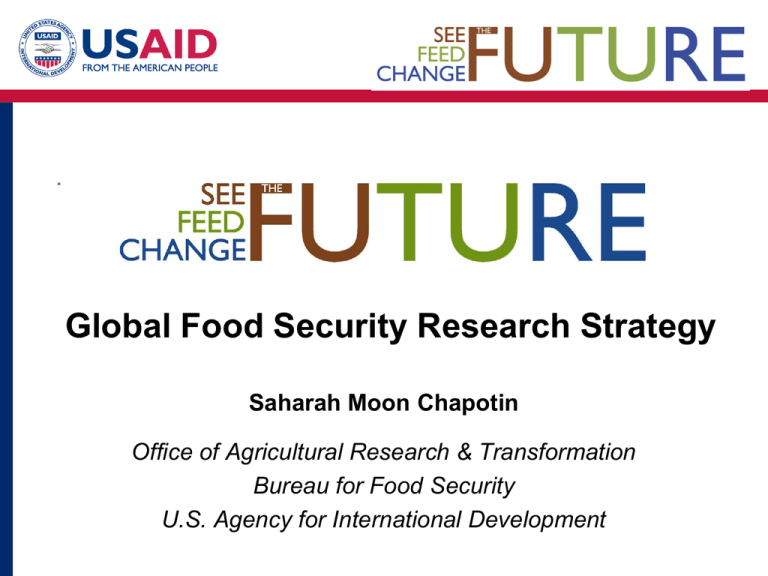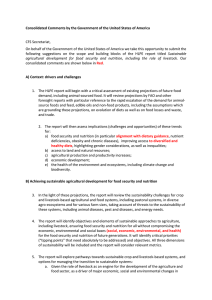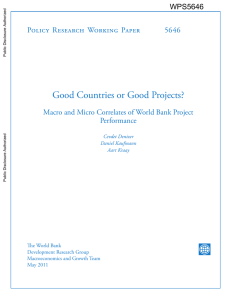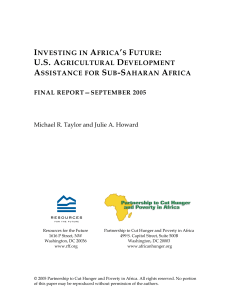Feed the Future Research Strategy
advertisement

Global Food Security Research Strategy Saharah Moon Chapotin Office of Agricultural Research & Transformation Bureau for Food Security U.S. Agency for International Development Feed the Future Global Food Security Research Strategy FTF Research Strategy aims to: • Increase agricultural productivity and reduce environmental impact • Improve markets, institutions and policies • Raise smallholder incomes and resilience • Increase availability of and access to nutritious foods Specific Objectives: • Problem-focused agricultural research • Global & regional/country-level public goods research • Adaptive research at country-level • Integrates biophysical sciences, social sciences, policy research • Capacity building is underlying theme Cross-cutting themes - to foster inclusive, sustainable agricultural productivity gains and improvements in child nutrition • Resilience to climate change • Sustaining natural resource base • Gender awareness/inclusivity Defining FTF Research Priorities Using poverty & nutrition lens, identify key production systems where hunger and poverty are significant… Prevalence Sub-national poverty ca. 2005 (<$1.25/day) Number Source: Stan Wood et al. (IFPRI) 2009. Child stunting Source: USAID and IFPRI, using Harvest Choice maps Farming Systems Dixon, 2001 This process led to focus on: What? Sustainable Intensification Where? Agro-ecologies in Focus Countries • Spillovers to region Who? Leveraging partnerships • • • • US Universities International Agriculture Research Centers National Agriculture Research Systems Private Sector Implementing the Research Strategy: • Building the research portfolio • Identify and engage partners • Link outputs to country-level programs & processes Building a Research Portfolio • Identify researchable constraints to production • Establish criteria for selection of priorities • Build pipeline of short, medium, long term impact • Manage risk with portfolio approach – fewer high risk, more lower risk investments Investment criteria • • • • • Relevance to poverty, women and children and food security Likelihood of success: Technical merit and pathways for adoption Cost/Benefit considerations Economic sustainability for producers/adopters Natural resources sustainability: water, soil, ecosystem and climate change • Institutional sustainability and impact on capacity: engagement of national and regional partners • Time Frame: timeline, milestones • Risks: potential impacts on vulnerable groups, environment or breakdown in key pathways Consultative Process In collaboration with BIFAD, USDA, APLU • January 2011 – Meeting at Purdue with research community • May 2011 – Global e-consultation on research strategy • June 21-23, 2011 – Forum for stakeholders in Washington, DC FTF Research Themes • Advancing the Productivity Frontier • Transforming Key Production Systems • Enhancing Nutrition and Food Safety Advancing the Productivity Frontier • Overcoming major crop and livestock productivity constraints: increase yields and incomes • Breeding and genetics for major crops & livestock • Livestock infectious diseases • Aquaculture systems management • Livestock feed improvements (availability/quality) • Policies and partnerships for technology adoption Increasing crop resilience to climate change Abiotic stress tolerance research to address major emerging global challenges: – Rising temperatures – Water availability – Climate variability – Population pressure – Resource use – Land availability Methods: conventional breeding & advanced molecular approaches Source: Chris Rey, University of the Witwatersrand, South Africa Cassava Resistant to mosaic disease in E. Africa Source: Agricultural Research Council, S. Africa Genetic Engineering of African Staple Crops: Solving production constraints that cannot be solved using conventional breeding Insect resistant potato in S. Africa Banana resistant to black sigatoka disease in E. Africa Insect resistant cowpea in Nigeria Source: Larry Beachj Source: Larry Beach Capacity building in biosafety policy and regulatory science • Building decision-making capacity on biotechnology • Enhance capability of partners to develop fully functional biosafety systems – Necessary to evaluate new applications of biotechnology – Ensure that only safe products of biotechnology are deployed, absence of biosafety framework precludes all adoption – Includes tools and information to assess safety and make decisions on introduction of new products • Necessary component of enabling policy environment for technology adoption– also seed laws and IPR Enhanced Nutrition & Food Safety • Grain legume productivity o • • • • Abiotic stress tolerance, nitrogen fixation, disease/pest resistance, system integration Biofortification of staple crops Reduce/eliminate mycotoxin contamination Reduce post-harvest losses Decision making and behavioral change for improved nutrition • Improved policies for nutrition and food safety Transforming Key Production Systems • Integrate global technology with site specific natural resource, social science, and market research • Link global research partners with regional & national • Integrate research with development interventions Rice-Wheat system of South Asia East Africa highlands system Southern & East African maize-based systems West African Sudano-Sahelian systems rea Area Sustainable intensification – more with less Yield South Asia Yield Sub-Saharan Africa Cereal Systems in the Indo-gangetic Plains • Home to 900M people (1/7 world population) • Dominated by rice-wheat, rice-rice, rice cotton systems • Breadbasket of S. Asia • Key constraints o Water availability o Labor Shortages o Soil erosion/nutrient depletion o Available land o Climate change Source: IRRI Intensifying production in South Asian cereal systems Target Interventions Outcomes • Retention of Crop Residues • Reduced erosion / run-off • Minimal/zero Tillage of Soil • Improved water and nutrient use efficiency & soil health • Innovative Cropping Systems • Mechanization • Improved Varieties • Better Policies • New crops in rotations • Reduced labor costs • Climate change adaptation • Improved total factor productivity (not just yield!) Capacity Building at All Levels • Agricultural education, extension, training, policies and research • Capacity of smallholders to use new scientific innovations and technologies • Integrate capacity development and research investments for maximum impact and sustainability • Capacity needs for monitoring and evaluation (M&E) Global Research Partners • US Universities – Collaborative Research Support Programs and other collaborations – Other Competitive Grants Programs (USDA/NIFA, NSF BREAD, etc.) • • • • CGIAR NARS partners in Focus Countries Private sector companies and institutions USDA/USAID Norman Borlaug Commemorative Research Initiative Linking research outcomes to end-users • USAID Mission country-level programs – Bring innovations to farmers – Enhance market access (infrastructure, information systems) – Engage governments (national and local) to adopt and implement enabling policies – Improve local capacity for research, policy making • USAID/Washington centrally-funded programs – Building research capacity – Developing global extension platform www.feedthefuture.gov Feed the Future the U.S. government’s global hunger and food security initiative



